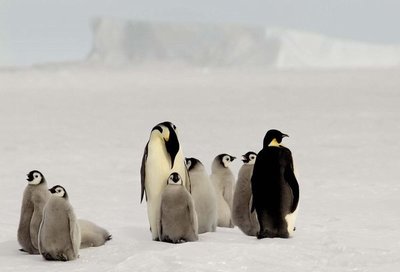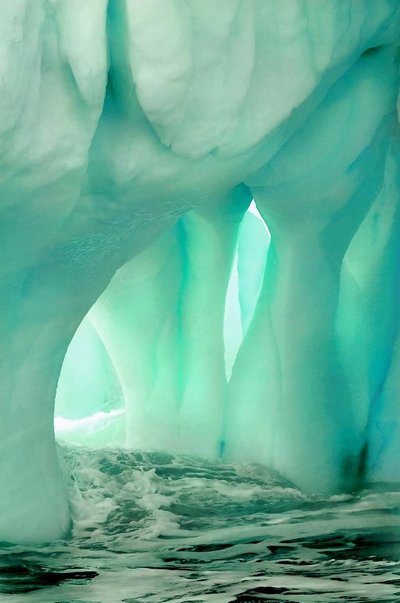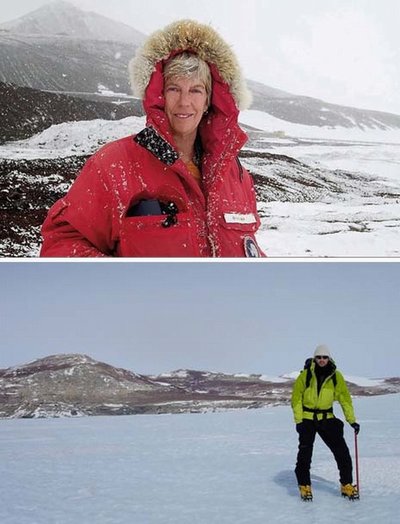October 1, 2009
‘Wondrous Cold’: Smithsonian exhibit on Antarctica visits Burke; UW Antarctic research also featured
What’s it like to live and work in Antarctica, the world’s coldest, windiest, driest and most remote continent on Earth? A new traveling exhibit coming to the Burke Museum called Wondrous Cold: An Antarctic Journey explores the question through the dramatic, large-format photography of Joan Myers, who spent more than a year on the frigid continent.
The exhibit will be supplemented by information about the UW’s own extensive research efforts in Antarctica. Research led by the UW’s Christian Sidor, associate professor of biology and the Burke’s curator for vertebrate paleontology, has led to the discovery of a previously unknown species — an amphibious predator distantly related to modern salamanders and frogs but 15 feet long — as well as burrows created by early vertebrates in the Early Triassic epoch, which was about 245 million years ago.
Wondrous Cold will feature 50 striking photographs by Myers — color and black and white scenes of wildlife, people and the extraordinary panorama of the Arctic wilderness. Also seen are dramatic shots of the abandoned huts of early explorers Robert Falcon Scott and Ernest Shackleton. Some of the shots were taken in environments as cold as -60 degrees Fahrenheit.
The exhibit will open Saturday, Oct. 3, at the museum with a special day of activities including talks by Sidor, Eric Steig, UW professor of Earth and space sciences; and by Thomas Tobin, a UW graduate student. The exhibit will remain up through Nov. 29.
Wondrous Cold was developed by the Smithsonian Institution’s Traveling Exhibition Service. The project came from a 2002 Artists and Writers grant Myers received from the National Science Foundation to photograph at McMurdo Station, surrounding field stations, historic locations and the South Pole during the 2002-2003 austral summer, a five-month period between November and March.
“I have seen part of the planet that few have seen, and I have had the time to walk and photograph and feel our world without its veneer of human activity,” Myers wrote about the exhibit on her Web site. “Antarctica cannot be tamed.”
The exhibit began its life at the Smithsonian National; Museum of Natural History in Washington, D.C., where it ran from May to July of 2006 before embarking on a 15-city tour that will last through the spring of 2010.
Wondrous Cold’s opening day, Oct. 3, will feature special events and lectures. Here’s the day’s agenda:
- 10:30 a.m.: Christian Sidor will discuss the two expeditions he undertook to Antarctica, where he collected 245-million-year-old fossils that are now part of the Burke’s collection.
- 11:30 a.m.: Cheryl Leonard, a composer, spent a month last winter visiting Palmer Station, one of three U.S. research stations in Antarctica, on a National Science Foundation Antarctic Artists and Writers grant. During her month on the ice she searched out and recorded natural soundscapes. Leonard will share stories, photos and unique audio recordings of wind, ice, birds and animals from her adventures at Palmer Station.
- 1 p.m.: Eric Steig, UW professor of Earth and space sciences and director of the Quaternary Research Center, will discuss what ice records reveal about long-term Antarctic climate change.
- 2 p.m.: Thomas Tobin, a second-year UW graduate student in Earth and space sciences and astrobiology, will discuss his field work traveling to Antarctica by boat to explore the Cretaceous Tertiary mass extinction that occurred there 65 mission years ago.
Two other events also have been scheduled in relation to Wondrous Cold:
- Sunday, Oct. 18: Ice Age Archaeology. Join Burke archaeologists and other specialists for a day of exhibits and talks on what life was like during the coldest time the state has ever known. Get the inside scoop on human life 12,000 years ago. Try your hand at the ancient skill of attaching a spear point to a shaft. See and touch fossils of the giant animals who shared the earth with people during a time when the environment was radically different.
- Thursday, Nov. 12: Jurassic Dinosaurs from Antarctica. William Hammer or Augustana College in Rock Island, Ill., has led six expeditions to Antarctica. Press notes for Hammer’s lecture at the Burke, state he will discuss, “Jurassic dinosaurs, scavenging theropods, a new sauropodomorph, a “beaver-like” tritylodont (and) a pterosaur or flying reptile, as well as other Jurassic finds from his over 30 years of research into the secrets of Antarctica.”
For more information about this exhibit or other programs and exhibits at the Burke Museum, visit online at www.burkemuseum.org.



